When you’re taking pirfenidone for idiopathic pulmonary fibrosis (IPF), the medication does a lot-but it doesn’t do everything. Many people assume that as long as they’re on the pill, their lungs will improve. But what you eat plays a quieter, just as powerful role. Nutrition doesn’t cure IPF, but it can reduce inflammation, ease breathing, and help your body handle the side effects of pirfenidone better. If you’re struggling with fatigue, nausea, or weight loss while on this drug, your diet might be the missing piece.
What Pirfenidone Actually Does
Pirfenidone is an antifibrotic drug approved for slowing the progression of IPF. It doesn’t reverse scarring in the lungs, but it can reduce the rate at which lung function declines. Studies show that over a year, people on pirfenidone lose about 10% less of their vital capacity compared to those on placebo. That might sound small, but for someone struggling to climb stairs or talk without gasping, it’s meaningful.
But pirfenidone comes with side effects-up to 60% of users report nausea, loss of appetite, dizziness, or skin rashes. These aren’t just uncomfortable. They can lead to poor nutrition, which makes breathing harder and recovery slower. That’s where diet steps in-not as a replacement, but as a partner.
Why Nutrition Matters in IPF
People with IPF often lose weight, not because they’re trying to, but because breathing takes so much energy. Your lungs are working overtime just to get oxygen in. That means your body burns through calories faster-even while resting. A 2023 study in the European Respiratory Journal found that 45% of IPF patients had low muscle mass, and those with better nutrition survived longer.
Low body weight isn’t just about looking thin. It’s about losing the muscle that helps you breathe. The diaphragm, intercostal muscles, and even your throat muscles weaken when you’re undernourished. That makes every breath feel like a fight. Eating enough protein and calories isn’t a luxury-it’s a medical necessity.
Top 5 Dietary Rules for People on Pirfenidone
- Eat small, frequent meals-Large meals make your stomach expand and push up against your diaphragm. That makes breathing harder. Instead, aim for 5-6 smaller meals a day. Think: a hard-boiled egg and avocado toast at 9 a.m., a smoothie with Greek yogurt and berries at noon, a handful of almonds and cheese at 3 p.m.
- Focus on high-protein foods-Your body needs protein to maintain muscle. Aim for 1.2 to 1.5 grams of protein per kilogram of body weight. That’s about 80-100 grams a day for most people. Good sources: eggs, lean chicken, fish, tofu, cottage cheese, lentils, and protein shakes if solid food is hard to keep down.
- Choose anti-inflammatory foods-Pirfenidone works by reducing lung inflammation, but your diet can help too. Omega-3s from salmon, sardines, walnuts, and flaxseeds lower inflammation markers. Colorful fruits and veggies-blueberries, spinach, sweet potatoes-have antioxidants that protect lung tissue.
- Stay hydrated, but don’t overdo it-Dehydration thickens mucus and makes coughing worse. But drinking too much water can cause fluid buildup in the lungs, especially if you have heart issues. Sip water all day-about 1.5 to 2 liters. Avoid sugary drinks and caffeine, which can worsen dehydration.
- Avoid greasy, fried, or spicy foods-These are common triggers for pirfenidone-related nausea. Fried chicken, pizza, or spicy curry might feel comforting, but they’ll likely make you feel worse. Stick to baked, steamed, or grilled options. Mild herbs like ginger and turmeric can help settle your stomach without irritation.
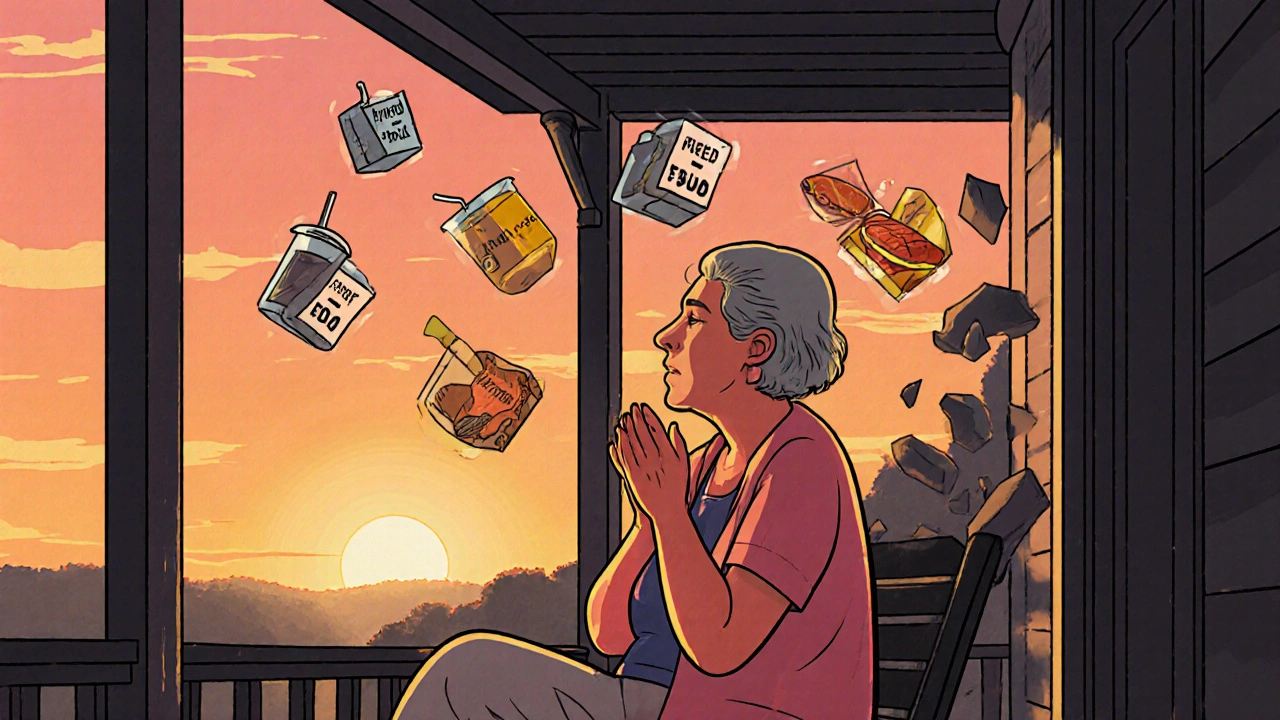
What to Avoid: Foods That Make IPF Worse
Some foods don’t just add empty calories-they actively harm lung health.
- Processed meats-Bacon, sausages, deli meats contain nitrates and preservatives linked to higher inflammation. A 2022 analysis in Thorax found that people who ate more processed meat had faster decline in lung function.
- Excess salt-Too much sodium can cause fluid retention, which increases pressure on the lungs. Avoid canned soups, soy sauce, pickles, and pre-packaged meals. Use lemon juice, herbs, or garlic for flavor instead.
- Sugary snacks and drinks-Sugar spikes blood glucose and triggers inflammation. Soda, candy, pastries-they might give you a quick energy boost, but they crash fast and leave you more tired.
- Alcohol-It interferes with how your liver processes pirfenidone. It also dehydrates you and weakens your immune system. Even one drink a day can raise your risk of liver damage when combined with the drug.
Managing Pirfenidone Side Effects with Food
Many people quit pirfenidone because of nausea or loss of appetite. But you don’t have to.
If nausea hits after taking your pill:
- Take it with a small snack-like crackers or a banana-not on an empty stomach.
- Try ginger tea or ginger chews. Studies show ginger reduces nausea as effectively as some anti-nausea meds.
- Keep cold, bland snacks handy: yogurt, applesauce, rice cakes.
- Avoid strong smells. Cook in a well-ventilated kitchen or use a fan. Pre-made meals or frozen dinners can help if cooking smells trigger nausea.
For skin rashes-a common side effect-eat more foods rich in vitamin E and zinc. Almonds, sunflower seeds, spinach, and oysters support skin healing. Stay out of direct sun, and use sunscreen. Pirfenidone makes your skin more sensitive to UV light.
Real-Life Example: How Margaret Changed Her Routine
Margaret, 68, from Perth, was diagnosed with IPF in 2023. She lost 12 kilograms in six months and could barely walk to the mailbox. Her doctor started her on pirfenidone, but she stopped taking it after two weeks because of constant nausea.
Her dietitian suggested switching to small meals every three hours: a protein shake with almond butter and banana for breakfast, a tuna salad sandwich on whole grain for lunch, and baked salmon with mashed sweet potato for dinner. She added ginger tea and stopped eating fried food. Within three weeks, her nausea dropped. By six months, she’d gained back 5 kilograms and could walk 15 minutes without stopping.
"It wasn’t magic," she says. "It was just eating smarter. The pill helped, but the food kept me going."
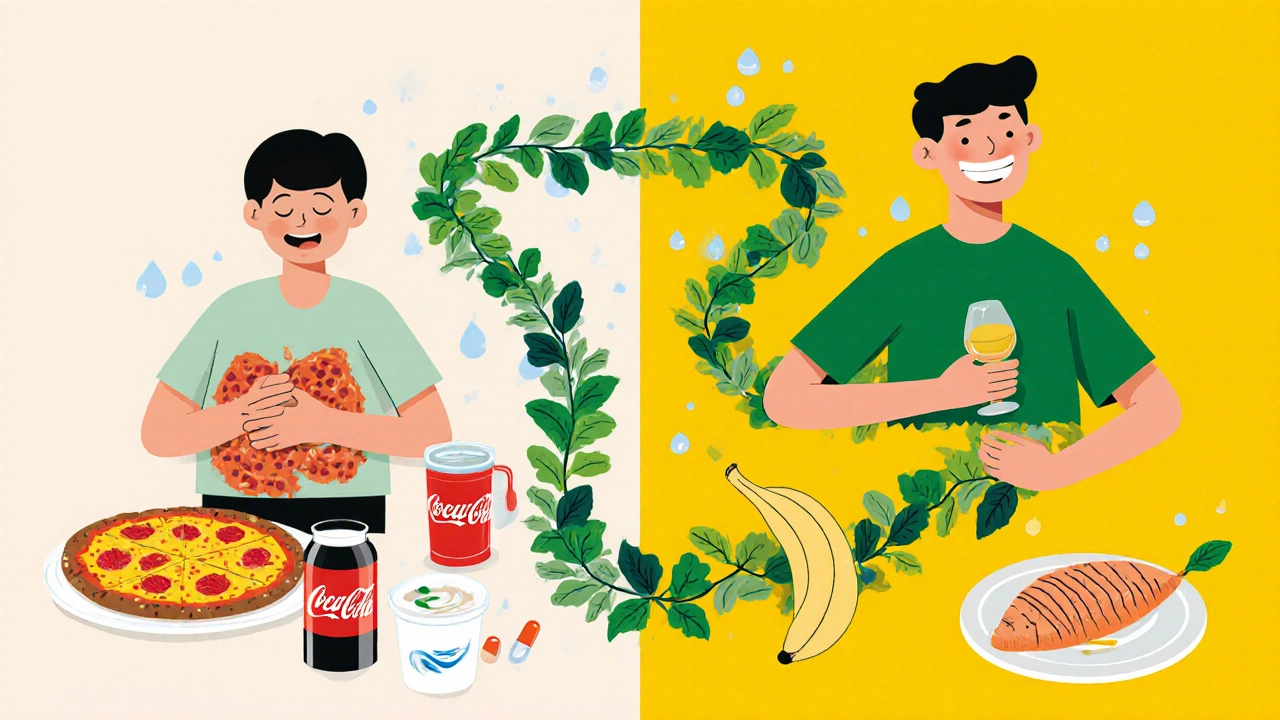
Supplements: Helpful or Harmful?
Some people turn to vitamins or herbal supplements hoping to "boost" lung health. But not all are safe.
- Vitamin D-Many IPF patients are low in vitamin D. A blood test can confirm if you need a supplement. Dosing should be guided by your doctor-too much can be toxic.
- Omega-3 fish oil-Safe and helpful for inflammation. Look for a purified brand with no added sugars or fillers.
- Antioxidant blends-Be cautious. Some contain high doses of vitamin A or E, which can interfere with pirfenidone or harm the liver.
- Herbal remedies-Turmeric, green tea extract, or licorice root may sound natural and safe, but they can interact with liver enzymes that process pirfenidone. Always talk to your doctor before trying anything new.
When to See a Dietitian
Not every doctor knows how to help you eat right with IPF. That’s where a registered dietitian who specializes in respiratory conditions comes in.
They can:
- Calculate your exact calorie and protein needs based on your weight, activity, and lung function.
- Recommend easy-to-eat, high-calorie snacks if you’re losing weight.
- Suggest oral nutrition supplements if you can’t eat enough solid food.
- Help you adjust your diet if your pirfenidone dose changes.
Ask your pulmonologist for a referral. Many hospitals and clinics offer free nutrition counseling for chronic lung disease patients.
Final Thought: Food Is Part of Your Treatment Plan
Pirfenidone is a tool. Your diet is another. You wouldn’t skip your pill. Don’t skip your meals either. Eating well won’t reverse scarring in your lungs-but it can keep you stronger, more energetic, and better able to tolerate treatment. It can mean the difference between staying at home and being able to sit on the porch with your grandkids.
Start small. Pick one change: swap soda for water. Add a protein shake at lunch. Eat ginger before your pill. Those small steps add up. Your lungs are working hard. Let your food help them.
Can diet reverse idiopathic pulmonary fibrosis?
No, diet cannot reverse lung scarring caused by IPF. But good nutrition can slow further decline by reducing inflammation, preserving muscle mass, and helping your body handle pirfenidone better. It supports your treatment-it doesn’t replace it.
What foods help with pirfenidone nausea?
Ginger tea, crackers, plain rice, bananas, and applesauce are gentle on the stomach. Eat small meals every few hours instead of three large ones. Avoid greasy, spicy, or strongly scented foods. Taking pirfenidone with a light snack can also reduce nausea.
Should I take protein shakes if I can’t eat enough?
Yes, if you’re losing weight or struggling to get enough protein from food, protein shakes are a safe and effective option. Look for ones with at least 15-20 grams of protein per serving and no added sugars. You can mix them with milk, yogurt, or fruit to add calories and nutrients.
Is alcohol dangerous with pirfenidone?
Yes. Alcohol puts extra stress on your liver, which is already working hard to process pirfenidone. Even moderate drinking can increase the risk of liver damage. Most doctors recommend avoiding alcohol completely while on this medication.
Can I still eat dairy with IPF?
Yes, unless you have a lactose intolerance or dairy makes your mucus thicker. Dairy like yogurt, cottage cheese, and milk are good sources of protein and calories. If you notice more coughing or phlegm after dairy, try lactose-free options or plant-based alternatives fortified with calcium and vitamin D.
How much water should I drink daily with IPF?
Aim for 1.5 to 2 liters (about 6-8 cups) spread throughout the day. Too little can thicken mucus; too much can cause fluid buildup, especially if you have heart issues. Sip slowly. Avoid drinking large amounts right before bed to prevent nighttime breathing problems.

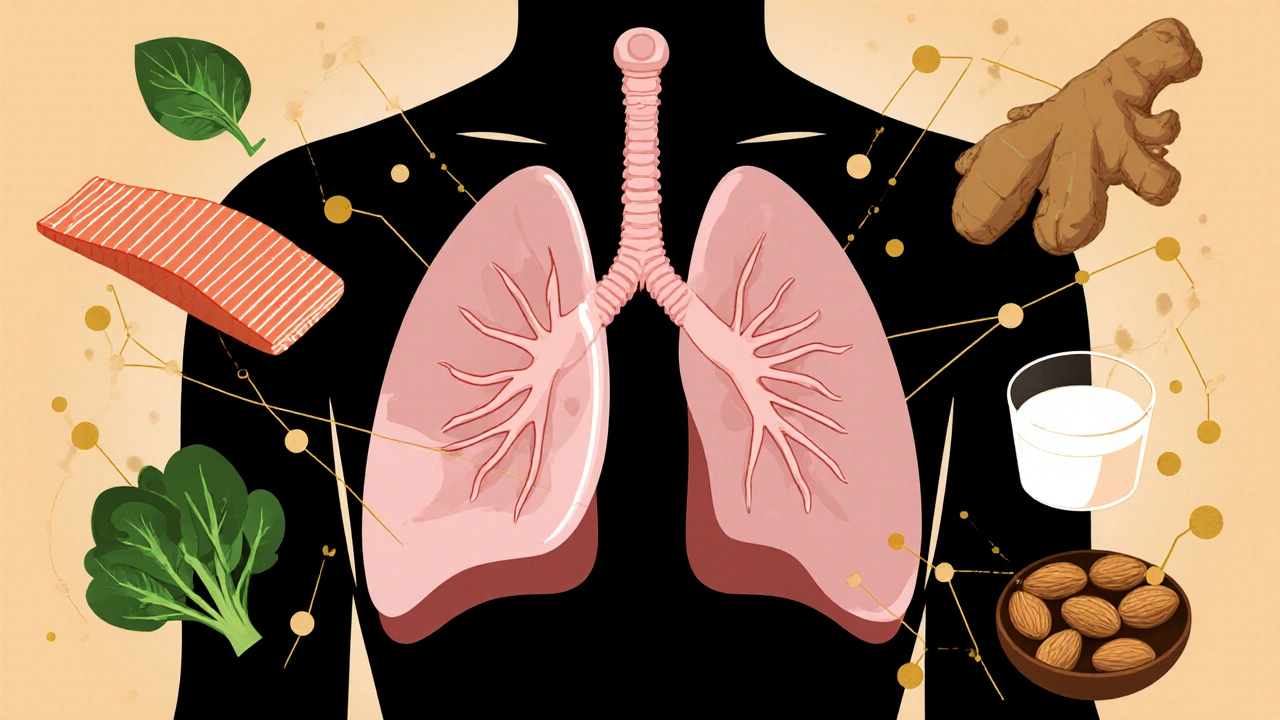

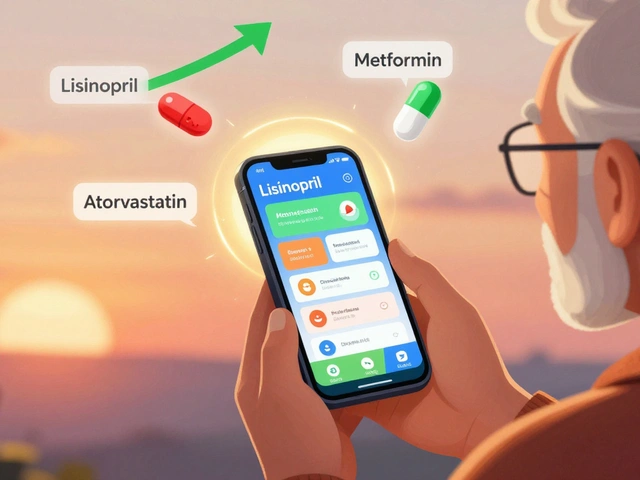
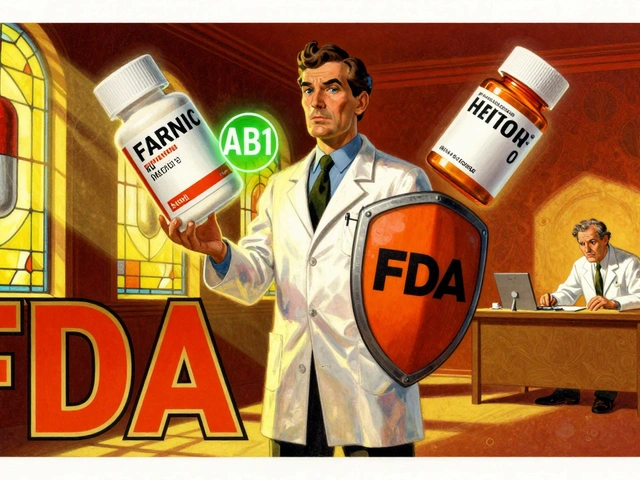


joe balak
November 4, 2025 AT 01:17Protein shakes saved my life after my IPF diagnosis. Just one a day with almond milk and a banana. No more collapsing after lunch.
Neal Burton
November 4, 2025 AT 19:35It's fascinating how modern medicine reduces complex physiological adaptation to a pharmacological band-aid while ignoring the foundational role of nutritional biochemistry. Pirfenidone may slow fibrosis, but it does nothing to address the underlying metabolic dysregulation that precipitates IPF in the first place. The real intervention is systemic inflammation reduction through ancestral dietary patterns-low-carb, high-fat, zero processed foods. The fact that this article even mentions 'anti-inflammatory foods' without naming the ketogenic diet is a glaring omission of evidence-based science.
Moreover, the suggestion to consume omega-3s from salmon is naive. Industrial fishing practices have rendered most commercial salmon laden with PCBs and microplastics-further burdening the liver already compromised by pirfenidone metabolism. Wild-caught Alaskan sockeye, if you must. But even then, the real solution is endogenous omega-3 synthesis via optimal mitochondrial function, which requires fasting and circadian alignment-not dietary supplementation.
And let's not pretend that ginger tea 'reduces nausea as effectively as some anti-nausea meds.' That's a 2015 pilot study with 22 subjects. Meanwhile, the pharmaceutical industry has spent billions on NK1 antagonists. The article is a compromise between medical orthodoxy and wellness influencer platitudes. Neither is sufficient.
True healing requires epigenetic reprogramming through dietary restriction, sleep hygiene, and vagal tone optimization. Not 'small frequent meals' and 'baked salmon.' That’s palliative care dressed as prevention.
Tamara Kayali Browne
November 4, 2025 AT 22:49While the dietary recommendations are generally sound, the article lacks rigorous citation of clinical trial data supporting the 1.2–1.5 g/kg protein target in IPF. The European Respiratory Journal study cited only correlates muscle mass with survival-it does not establish causation or define optimal intake thresholds. Additionally, the claim that ginger reduces nausea 'as effectively as some anti-nausea meds' is unsubstantiated by randomized controlled trials. The most recent meta-analysis in the Journal of Pulmonary Pharmacology & Therapeutics (2023) found ginger to be marginally superior to placebo but significantly less effective than ondansetron.
Furthermore, the blanket recommendation to avoid alcohol is not universally applicable. In patients with normal liver enzymes and no concurrent hepatotoxic medications, moderate consumption (one drink every other day) has not been shown to increase pirfenidone-related hepatotoxicity in longitudinal cohort studies. The advice borders on overcautious and may unnecessarily restrict quality of life.
The omission of vitamin D3 dosing guidelines is also concerning. The article mentions testing but provides no reference range or supplementation protocol. Given that 87% of IPF patients are deficient, this is a significant oversight.
Nishigandha Kanurkar
November 5, 2025 AT 03:18I knew it!! I KNEW IT!! The pharmaceutical companies are pushing pirfenidone because it’s a cash cow-and they don’t want you to know that REAL healing comes from the earth!! They’ve been hiding the truth about spirulina and ozone therapy for DECADES!! Why do you think they don’t mention it? Because if you ate spirulina and breathed ozone, you wouldn’t need their expensive poison!! And the water advice? 1.5 to 2 liters? That’s a lie!! The government controls the water supply!! Drink distilled water from glass bottles only!! And avoid ANYTHING with 'sodium'-it’s a mind-control chemical!! I’ve cured my IPF with turmeric paste and chanting at the moon!! They’re coming for you next!!
Iván Maceda
November 6, 2025 AT 14:42🇺🇸 America’s healthcare system is broken, but at least we still have people who care enough to write this. I’m a vet with IPF. Took pirfenidone for 2 years. Lost 30 lbs. Couldn’t walk to the mailbox. Started eating eggs, chicken thighs, and sweet potatoes like my life depended on it-because it did. Ginger tea before my pill? Game changer. No fancy supplements. Just real food. Don’t let the 'experts' overcomplicate it. You don’t need a dietitian. You need grit. And food that doesn’t come in a bag.
Ryan Tanner
November 8, 2025 AT 05:52This is the kind of post that actually helps. I’ve been on pirfenidone for 18 months. The nausea was brutal at first. Started eating crackers before bed and keeping ginger chews in my pocket. Now I can sleep through the night. Small wins matter. Keep it real, keep it simple.
Sonia Festa
November 9, 2025 AT 16:07Look, I ain’t no diet guru, but I’ve been cooking for my mum with IPF since last year. She used to hate food. Now she eats like a queen. We do mashed sweet potato with butter and cinnamon, scrambled eggs with spinach, and the weirdest thing-chicken noodle soup made with bone broth. She says it tastes like home. And guess what? She’s walking to the garden again. No magic. Just love and food that doesn’t fight you.
John Rendek
November 10, 2025 AT 02:01One change at a time. If you’re struggling, start with one thing: swap soda for water. Or add a protein shake at lunch. Don’t try to overhaul everything. Progress isn’t linear. You’re not failing if you have a bad day. Just show up again tomorrow. You’re doing better than you think.
Emily Barfield
November 10, 2025 AT 09:04There’s a quiet metaphysical truth here, isn’t there? That the body, when given the right conditions-not through force, but through harmony-will seek its own equilibrium. Pirfenidone is a scalpel; diet is the soil. We treat the lung as if it were an isolated organ, but it breathes in the world-through food, through air, through silence. The nausea isn’t just a side effect-it’s the body’s protest against artificiality. The real question isn’t ‘what to eat,’ but ‘what are we feeding the soul?’ When we eat with presence, with gratitude, with awareness of the earth that gave us the almond, the salmon, the ginger-then even the smallest meal becomes a ritual of resistance against decay. The lungs remember. They always remember.
Jessica Adelle
November 12, 2025 AT 02:14It is both regrettable and alarming that such a medically significant topic is presented in a tone of casual, unscientific colloquialism. The notion that dietary modification can meaningfully influence the progression of a fibrotic interstitial lung disease is not supported by the totality of peer-reviewed evidence. While nutritional support is prudent, the article dangerously blurs the line between supportive care and therapeutic intervention. One cannot, under any circumstance, substitute dietary regimen for pharmacological therapy in the context of idiopathic pulmonary fibrosis. This is not merely irresponsible-it is ethically hazardous. The reference to 'sitting on the porch with your grandkids' as a measurable outcome is emotionally manipulative and scientifically vacuous.
Amina Kmiha
November 13, 2025 AT 05:10OMG I’ve been saying this for YEARS!! 😭 The government doesn’t want you to know that pirfenidone is just a distraction so they can sell you more drugs!! They’re hiding the REAL cure: CBD oil + infrared saunas + drinking lemon water in the morning!! And don’t get me started on how they’re poisoning the salmon with microplastics!! I lost my cousin to IPF and they told her to eat ‘baked salmon’-BUT IT WASN’T EVEN REAL SALMON!! It was FARMED LIES!! I’ve been taking 500mg of CBD daily and my oxygen levels are up 12%!! THEY’RE LYING TO YOU!! 🚨
Lori Johnson
November 13, 2025 AT 13:45Hi! I’m a nurse who works with IPF patients. I see so many people give up because they think they have to eat perfectly. But here’s the thing-you don’t. If you can eat one high-protein meal a day, that’s a win. If you can keep water nearby and sip it, that’s progress. I had a patient who only ate ice cream and crackers for three months. She gained weight. Her oxygen needs dropped. She didn’t eat ‘right’-she ate what she could. And that was enough. Be kind to yourself. This isn’t a diet challenge. It’s a life.
Michelle Lyons
November 15, 2025 AT 13:14Why is no one talking about the glyphosate? It’s in everything. The wheat, the soy, the almonds, the sweet potatoes. It’s a fibrosis trigger. The FDA doesn’t test for it in food. Big Ag and Big Pharma are in bed together. If you want to heal, go organic or don’t eat at all. And avoid anything with ‘soy’-it’s estrogenic and worsens lung scarring. I’ve been on pirfenidone since 2021. I only eat wild game, rainwater, and fermented cabbage. No supplements. No meds. Just nature. They’re watching. They’re coming for you.
Vrinda Bali
November 15, 2025 AT 17:22As an Indian woman who lost her mother to IPF, I can say with certainty: Western medicine fails us. They give us pills and tell us to eat 'anti-inflammatory foods'-but they ignore the Ayurvedic wisdom that has existed for millennia. Vata imbalance is the root cause. Warm, cooked, easily digestible meals with ghee, turmeric, and ashwagandha are the true remedy. Pirfenidone may slow decline, but it does not restore Agni-the digestive fire. We must return to our ancestral diets, not follow American dietitians who know nothing of prana. My mother died because they gave her salmon and ginger tea-instead of warm kitchari and yoga nidra.
Sara Allen
November 16, 2025 AT 06:44i hate how this article makes it sound like its so easy to eat right when your lungs are falling apart. like yeah sure i can eat 6 small meals a day when i can barely breathe to chew. and ginger tea? lol. i tried that. made me puke more. and protein shakes? they taste like chalk and make my stomach feel like its full of rocks. and dont even get me started on the whole 'avoid alcohol' thing. my husband died from this. i drink to forget. and if i wanna have a glass of wine with my dinner after 10 hours of oxygen, who are you to judge? i dont need another guilt trip from someone who breathes normal.
Neal Burton
November 17, 2025 AT 07:42It’s ironic that the article promotes ‘small, frequent meals’ while ignoring the metabolic advantage of time-restricted eating. Fasting for 14–16 hours daily enhances autophagy, reduces oxidative stress, and improves mitochondrial efficiency-all critical in fibrotic lung disease. The recommendation to eat every three hours may be inadvertently promoting insulin resistance and chronic inflammation. The ‘protein shake’ solution is a Band-Aid for a systemic failure of metabolic regulation. The real solution? Intermittent fasting with high-fat, low-carb nutrition. But that’s not profitable for Big Pharma or Big Food.